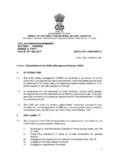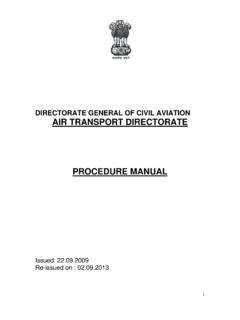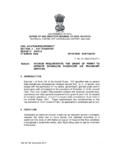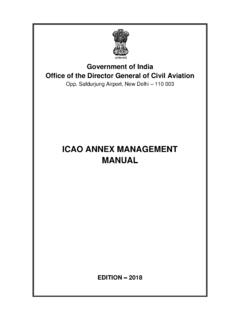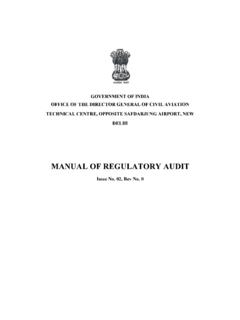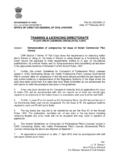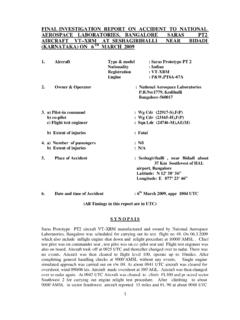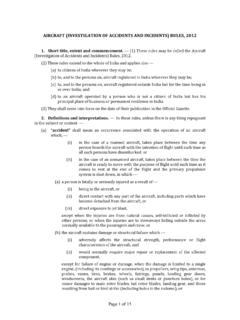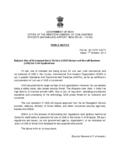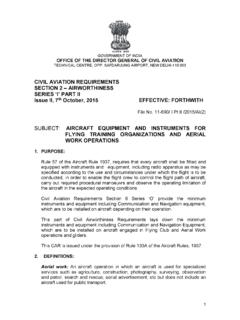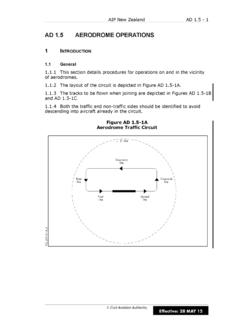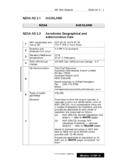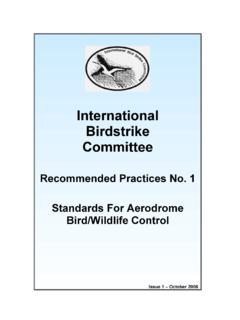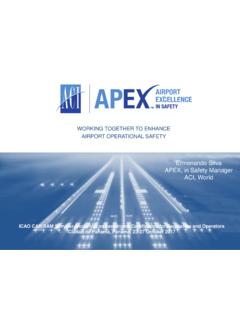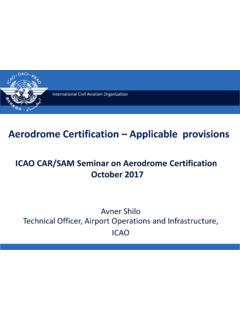Transcription of AERODROME ADVISORY CIRCULAR
1 1 GOVERNMENT OF INDIA OFFICE OF DIRECTOR GENERAL OF CIVIL AVIATION AD AC NO. 1 of 2012 16th November 2012 Rev. 1, 19thDecember 2012 Rev. 2, 27th January 2017 AERODROME ADVISORY CIRCULAR SUBJECT: Process for communicating with the DGCA on the planning, construction and commissioning of changes to airport infrastructure, and major maintenance programmes 1. INTRODUCTION AND PURPOSE As part of the licensing arrangements a licensed airport is required by Rule 83(2) of Aircraft Rules, 1937 and as a condition of the license, to seek the prior approval of the safety regulator, the Director General of Civil Aviation (DGCA) for AERODROME projects that change/add facilities, structures, hereafter referred to collectively as infrastructure, that may affect the safety of aircraft operation.
2 This is in addition to the obligation on the licensee to ensure that the AERODROME and its operation comply with licensing requirements, as well as its own safety requirements, if and where they are more stringent. The purpose of the Rule 83(2) obligation and license condition is for the DGCA, as the safety regulator, to be assured through documented evidence that the licensee has fully considered aircraft safety issues in the context of an infrastructure or major maintenance project and has: (a) Satisfied itself, through its internal change management and other relevant safety management processes, that the agreed safety performance criteria will not be compromised. (b) Reviewed exemptions to determine if the reason for the exemption can be corrected and when.
3 (c) For the licensee to demonstrate to the DGCA that the project is compliant with national safety requirements and that the agreed safety performance criteria will not be compromised. (d) That rigorous and comprehensive project planning has taken place. 2 This document has been developed in response to the need to improve the notification, management and safety oversight of projects that significantly change the infrastructure of an airport s overall facility and have the potential to introduce new or changed safety risks to aircraft using airports in India. Therefore, it is designed to assist both the DGCA as the safety regulator and service providers in that aim. It is worth emphasizing that the focus is on those aspects of development that relate, either directly or indirectly, to aircraft and not occupational safety or landside functions/processes, unless there is a link to aircraft safety.
4 So, for example, passenger processing in a new terminal will not be part of DGCA operational safety oversight unless it is designed with aircraft safety in mind. So, security and immigration will generally be the remit of the specialist authorities, not DGCA, but the areas/activities that interface with airside operations, say aerobridge operation will be an area of DGCA interest, either AERODROME or flight operations, depending on which party or party s contractor at the airport is the operator of the air bridge (it may well be an area of joint responsibility/interest). It should not be forgotten that overall building design may raise aircraft safety issues, whether airside or landside see item in the project context paragraph. Building integrity is usually a planning or building control/code issue.
5 This CIRCULAR is issued with the aim to guide AERODROME operators to prepare the proposals for submission to DGCA in proper and standardize manner. The DGCA, in partnership with industry, will review and amend this material in the light of usage and experience. 2. DEFINITIONS AND ABBREVIATIONS. When the following terms are used in this CIRCULAR they have the following meanings: Compliance. The meeting of CAR requirements, whether they are the equivalent to Standards mentioned therein. Hazard. A condition or an object with the potential to cause injuries to personnel, damage to equipment or structures, loss of material, or reduction of ability to perform a prescribed function (ICAO 9859, Edition 2). Hot Spot. A location on an AERODROME movement area with a history or potential risk of collision or runway incursion, and where heightened attention by pilots/drivers is necessary.
6 Infrastructure project. A building or structure (defined as an arrangement of parts). This could be a new or upgrade of facilities, a replacement or refurbishment of an existing facility or a major maintenance project that will cause operational disruption over a significant period of time. Such projects will have different significance in different contexts. For example, in terms of obstacle limitation surfaces, height will be the significant element, whereas for wildlife management the significant element will be attractiveness to wildlife. Probability. The likelihood of a specific outcome. 3 Risk specifically Safety Risk. A measure of the seriousness of, or put a number on, the consequences of hazards, expressed in terms of predicted probability and severity, from the consequences of a hazard.
7 Mitigation; more specifically safety risk mitigation. The means by which risk levels may be reduced by safety interventions/mitigation measures, in order to reduce the probability (the more normal means), or reduce the consequence. They are determined by using in-house and external expertise from a relevant range of airport, risk management and aircraft related operational departments, pro-actively monitoring operations and performance, and analyzing data. Safety Assurance Report. A structured argument, supported by a body of evidence that provides a compelling, understandable and valid case that change in a system/sub-system meets the service providers risk acceptability and change management criteria for a given application in a given operating environment.
8 It is more than risk management, or even a safety assessment, as it includes in its scope the outcomes of activities and assurances required by the change management process, such as testing prior to entry-into- service. Depending on the nature of the application and operating environment, a safety case may meet the requirement for a safety assurance report. Safety Performance metrics/criteria - Indicators and targets. Safety indicators are the parameters that characterize and/or typify the level of safety of a system; safety indicator value is the quantification of a safety indicator and safety targets are the concrete objectives of the level of safety, 3. APPLICABILITY The Accountable Executive at all the licensed aerodromes, as the person with overall accountability for safety management, or an appropriately delegated person, should identify projects that significantly change the infrastructure of an airport s overall facility and have the potential to introduce new or changed safety risks to aircraft using airports in India.
9 This CIRCULAR has been developed to assist that person in submitting the proposal along with required documents to DGCA for approval. INFRASTRUCTURE PROJECT OR MAINTENANCE PROGRAMME THAT MAY AFFECT RISKS TO SAFETY That is a question for the licensee to consider and answer as part of the change management process of its Safety Management System (SMS), but as guidance the following are areas and examples of infrastructure change to meet changes in operational requirements that can generate significant changes with the potential to affect aircraft safety, usually as a change in infrastructure design, during construction or during the commissioning; even when the end result is intended to be positive. These negative effects can be greater where there is significant disruption to traffic and/or greater exposure to the change.
10 For example, a protracted project timescale 4 - exposure time being a factor in probability of a hazard being realized. Such examples are those that should be brought to the notice of the DGCA. (a) Planned airport infrastructure change that introduces a new or upgraded facility/equipment: (i) A new or significantly extended building, usually in airside or at the interface of airside and landside, such as terminals. However, in some cases buildings at some distance from the movement area may have the potential to affect aircraft safety. For example, due to the height infringing an obstacle clearance surface. Alternatively, or even in combination due to factors such as the shape, orientation, height, surface finish, lighting, location relative to the runway or navigation aid transmissions, there may be the potential to: (aa) Generate wind-shear across a runway (building induced turbulence); (ab) create anomalies in radiated signals from navigation or surveillance aids especially in Cat-II/III operations; or (ac) create light distractions for pilots and Air Traffic Controllers.
